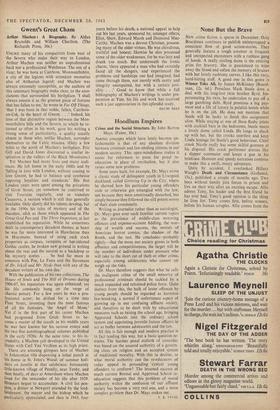Hoodlum Empires
Crime and the Social Structure. By John Barron Mays. (Faber, 30s.) AMONG concepts which have lately become un- fashionable is that of any absolute division between criminals and law-abiding citizens in onr modern society. This open-mindedness makes it easier for reformers to press for penal re- education in place of retribution, but it also raises some new problems.
Some years back, for example, Dr. Mays wrote a classic study of delinquent youth in Liverpool dockland, called Growing Up in the City, where he showed how his particular young offenders stole or otherwise got entangled with the law, not because they were emotionally disturbed, but simply because they followed the still potent mores of their slum community.
Writing as journalist rather than as sociologist, Dr. Mays goes over such familiar current topics as the prevalence of middle-class motoring offences and expense-account fiddling, the' wor- ship of wealth and success, the morals of American horror comics, the shadow of the Bomb, and the rest. He concludes—probably rightly—that the more our society grows in both affluence and competitiveness, the larger will be the number of individuals under pressure who will take to the short cut of theft or other crime, especially among adolescents who cannot yet weigh up the risks.
Dr. Mays therefore suggests that what he calls the malignant crime of the small minority of professional criminals should be tackled by a much expanded and retrained police force. Quite distinct from this, the bulk of lesser offences by young people should be regarded as harmless law-breaking, a normal if unfortunate aspect of growing up in our confusing affluent • society, and therefore to be dealt with by educational measures such as raising the school age, bringing Approved Schools into the ordinary school system and appointing juvenile liaison officers to act as buffer between adolescents and the law.
All this is fair enough and modern practice is in fact tending this way, but a basic question re- mains. The harsher penal outlook of yesterday was based on the assured authority of a govern- ing class, on religion and an accepted system of traditional morality. With this in decline, to what moral authority can the re-educators of today appeal in persuading cynical young offenders, to conform? The lessened success of much current Borstal and Approved School re- education suggests that this problem of moral authority within the confusion of our affluent society has become a very real one, and a more complex problem than Dr. Mays makes out.
T. R. V\ FI.






























 Previous page
Previous page